Equation of A Line Chapter Notes | Mathematics Class 10 ICSE PDF Download
Introduction
Dive into the exciting world of coordinate geometry with the "Equation of a Line"! Imagine straight lines as pathways on a graph, each telling a unique story through numbers and equations. This chapter unravels the mysteries of linear equations, slopes, and intercepts, guiding you to master the art of plotting lines, checking points, and understanding their relationships. From the gentle incline of a slope to the thrill of finding a line’s equation, you’ll explore parallel and perpendicular lines, intercepts, and more. Buckle up for a mathematical adventure that transforms the coordinate plane into your playground!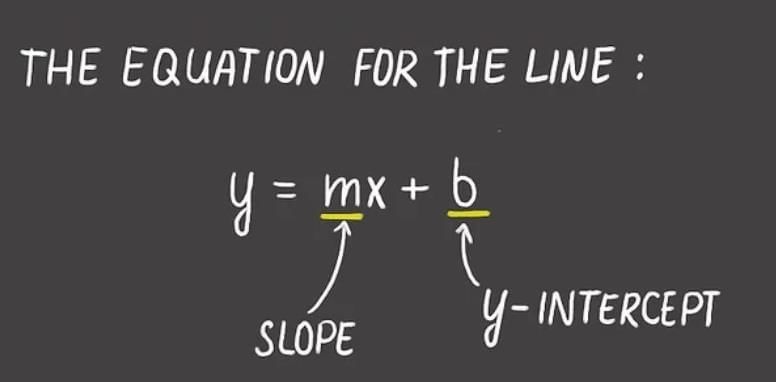
A Basic Concept
- Linear equations involve variables x and y, or just one, and are of the first degree.
- Each linear equation corresponds to a straight line on a graph.
- Every straight line can be described by a linear equation.
- Key points to note:
- A point is on a line if its coordinates fit the line’s equation.
- If a line goes through a point, that point’s coordinates satisfy the equation.
- Example: Check if point (4, -2) lies on the line 3x + 5y = 2.
- Step 1: Insert x = 4 and y = -2 into the equation 3x + 5y = 2.
- Step 2: Calculate: 3 × 4 + 5 × (-2) = 12 - 10 = 2.
- Step 3: Check: 2 = 2, so the equation is true.
- Conclusion: Point (4, -2) lies on the line 3x + 5y = 2.
Inclination of a Line
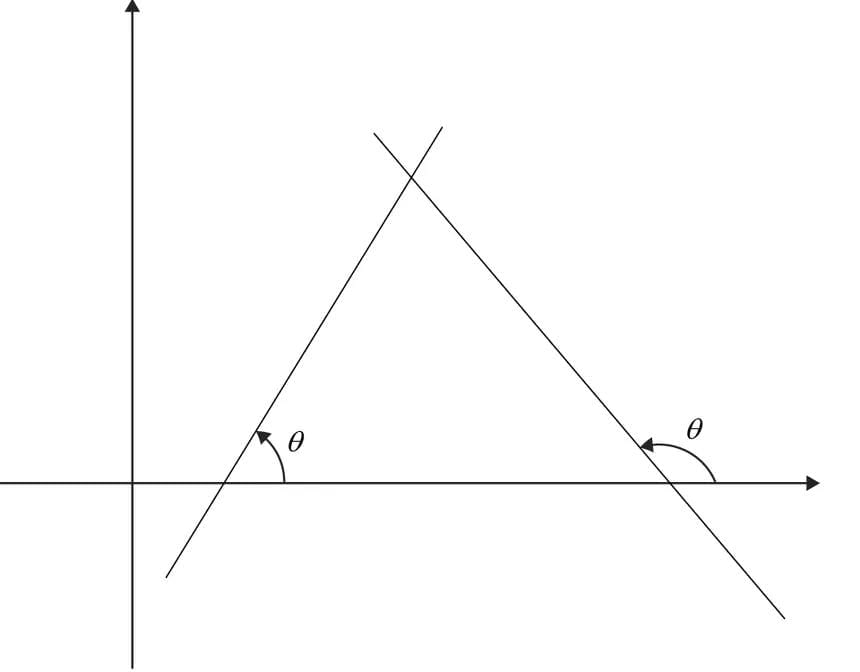
The inclination is the angle a line makes with the positive x-axis.
Steps to grasp inclination:- Counterclockwise measurement makes the angle (θ) positive.
- Clockwise measurement makes the angle (θ) negative.
- The x-axis and lines parallel to it have an inclination of 0°.
- The y-axis and lines parallel to it have an inclination of 90°.
Concept of Slope (or, Gradient)
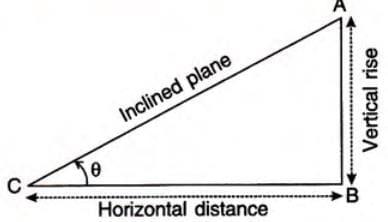
The slope indicates how steep a line is.
Steps to understand slope:
- Think of a line as an inclined plane.
- Slope is the ratio of vertical rise to horizontal distance.
- For a line, slope = vertical rise / horizontal distance.
Formula: Slope of line AC = AB / BC = tan θ, where θ is the angle with the horizontal.
Slope (or, Gradient) of a Straight Line
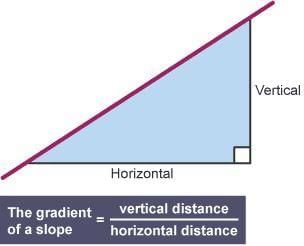
- The slope, denoted m, is the tangent of a line’s inclination.
- Formula: Slope m = tan θ, where θ is the inclination.
- Slope of the x-axis is 0 (θ = 0°, tan 0° = 0).
- Slope of the y-axis is undefined (θ = 90°, tan 90° is not defined).
- A positive slope means the line makes an acute angle (less than 90°) counterclockwise with the x-axis.
- A negative slope means the line makes an obtuse angle (greater than 90°) counterclockwise or an acute angle clockwise with the x-axis.
- Step 1: Apply the formula: m = tan θ.
- Step 2: Insert θ = 45°.
- Step 3: Calculate: m = tan 45° = 1.
- Conclusion: The slope of the line is 1.
The Slope of a Straight Line Passing Through Two Given Fixed Points
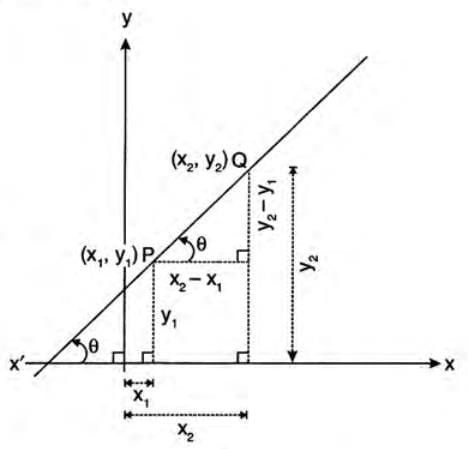
- Find the difference in y-coordinates (ordinates).
- Find the difference in x-coordinates (abscissae).
- Divide the y-difference by the x-difference.
Formula: Slope m = (y2 - y1) / (x2 - x1) or m = (y1 - y2) / (x1 - x2).
Example: Find the slope of the line through A(-2, 3) and B(2, 7).
- Step 1: Label points: A(-2, 3) = (x1, y1) and B(2, 7) = (x2, y2).
- Step 2: Use the formula: m = (y2 - y1) / (x2 - x1).
- Step 3: Substitute: m = (7 - 3) / (2 - (-2)) = 4 / 4 = 1.
- Conclusion: The slope of line AB is 1.
Parallel Lines
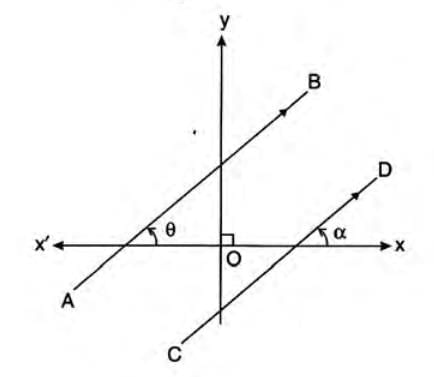
Two lines are parallel if they share the same inclination.
Steps to identify parallel lines:
- Consider lines AB and CD with inclinations θ and α.
- If parallel, then θ = α.
- Thus, tan θ = tan α.
- So, the slope of AB equals the slope of CD.
Property: Parallel lines have equal slopes.
Conversely, if slopes are equal, the lines are parallel.
Perpendicular Lines
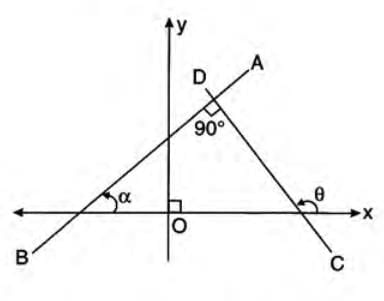
- Two lines are perpendicular if they meet at right angles.
- Steps to understand perpendicularity:
- Let lines AB and CD have inclinations α and θ.
- If perpendicular, then θ = 90° + α.
- Calculate: tan θ = tan (90° + α) = -cot α.
- Since cot α = 1 / tan α, then tan θ = -1 / tan α.
- Thus, tan θ × tan α = -1.
- Formula: If m1 and m2 are slopes of perpendicular lines, then m1 × m2 = -1.
- Conversely, if the product of slopes is -1, the lines are perpendicular.
Condition for Collinearity of Three Points
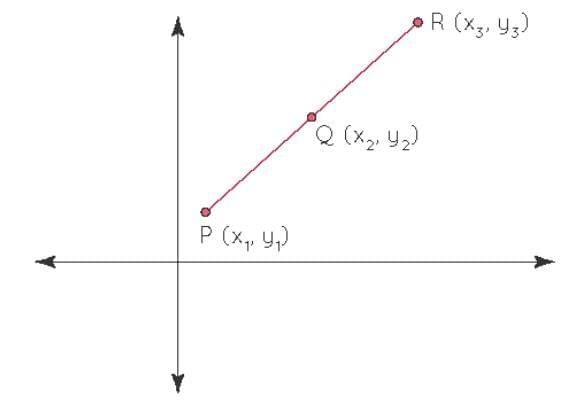 Three points A, B, and C are collinear if they lie on one straight line. Condition for collinearity:
Three points A, B, and C are collinear if they lie on one straight line. Condition for collinearity:- Compute the slope of line AB.
- Compute the slope of line BC.
- If the slope of AB equals the slope of BC, points A, B, and C are collinear.
- Step 1: Apply condition: Slope of AB = Slope of BC.
- Step 2: Slope of AB = (0 - 3) / (-5 - 2) = -3 / -7 = 3/7.
- Step 3: Slope of BC = (a - 0) / (-2 - (-5)) = a / 3.
- Step 4: Equate slopes: 3/7 = a / 3.
- Step 5: Solve: a = 9/7 = 1 2/7.
- Conclusion: The value of a is 9/7 or 1 2/7.
X-Intercept
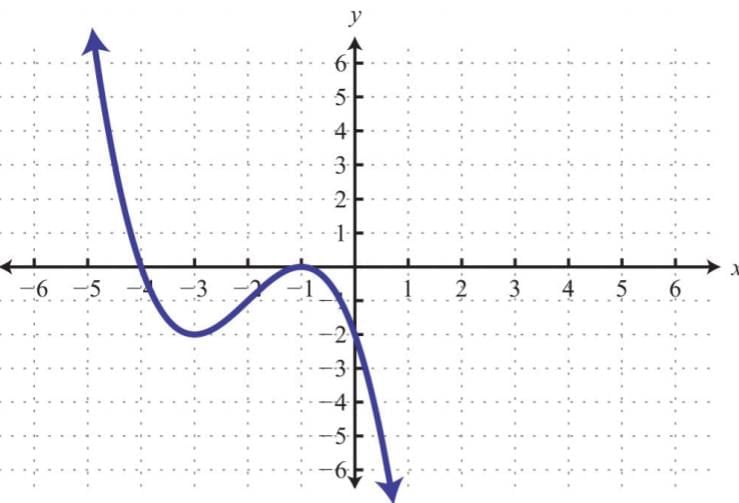
X-Intercept Point
- The x-intercept is the distance from the origin to where a line crosses the x-axis.
- Steps to find the x-intercept:
- Locate point A where the line meets the x-axis.
- The x-intercept is the x-coordinate of point A, i.e., OA.
- If x-intercept is 5, the point on the x-axis is (5, 0).
- If x-intercept is -8, the point on the x-axis is (-8, 0).
Y-Intercept
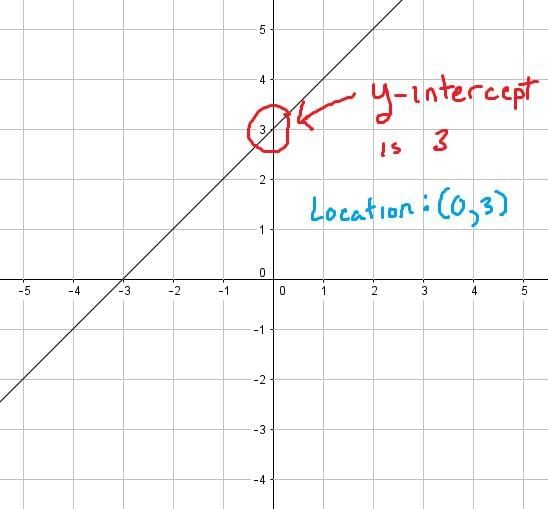
Y-Intercept Location
- The y-intercept is the distance from the origin to where a line crosses the y-axis.
- Steps to find the y-intercept:
- Locate point where the line meets the y-axis.
- The y-intercept is the y-coordinate of point.
- If y-intercept is 5, the point on the y-axis is (0, 5).
- If y-intercept is -6, the point on the y-axis is (0, -6).
Equation of a Line
A line can be expressed using various equation forms.
Type 1: Slope-Intercept Form
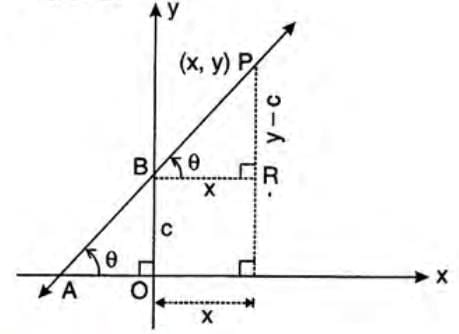 Used when slope and y-intercept are known.Steps to derive the equation:
Used when slope and y-intercept are known.Steps to derive the equation:
- Consider line AB making angle θ with the x-axis.
- Let y-intercept be c (point B is (0, c)).
- Slope m = tan θ.
- For any point P(x, y) on the line, tan θ = (y - c) / x.
- Rearrange: m x = y - c.
- Final form: y = m x + c.
Formula: y = m x + c, where m is slope and c is y-intercept.
Meaning of c:
- It’s the y-coordinate where the line crosses the y-axis.
- It’s the value of y when x = 0.
- Step 1: Given θ = 45°, so slope m = tan 45° = 1.
- Step 2: Given y-intercept c = 5.
- Step 3: Use slope-intercept form: y = m x + c.
- Step 4: Substitute: y = 1 x + 5.
- Conclusion: The equation is y = x + 5.
Type 2: Point-Slope Form
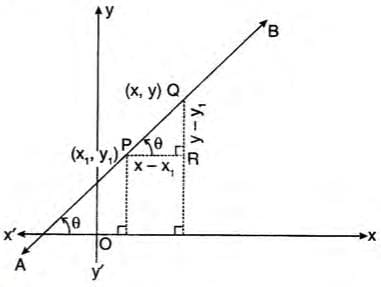 Used when slope and a point on the line are known.Steps to derive the equation:
Used when slope and a point on the line are known.Steps to derive the equation:- Let line AB have inclination θ and pass through P(x1, y1).
- Slope m = tan θ.
- Consider point Q(x, y) on the line.
- In triangle PQR, (y - y1) / (x - x1) = m.
- Rearrange to form the equation.
Formula: y - y1 = m (x - x1).
Example: Find the equation of a line with inclination 60° and passing through (-2, 5).- Step 1: Given θ = 60°, so slope m = tan 60° = √3.
- Step 2: Given point (x1, y1) = (-2, 5).
- Step 3: Use point-slope form: y - y1 = m (x - x1).
- Step 4: Substitute: y - 5 = √3 (x - (-2)).
- Step 5: Simplify: y - 5 = √3 (x + 2) → y = √3 x + 2√3 + 5.
- Conclusion: The equation is y = √3 x + 2√3 + 5.
Type 3: Two-Points Form
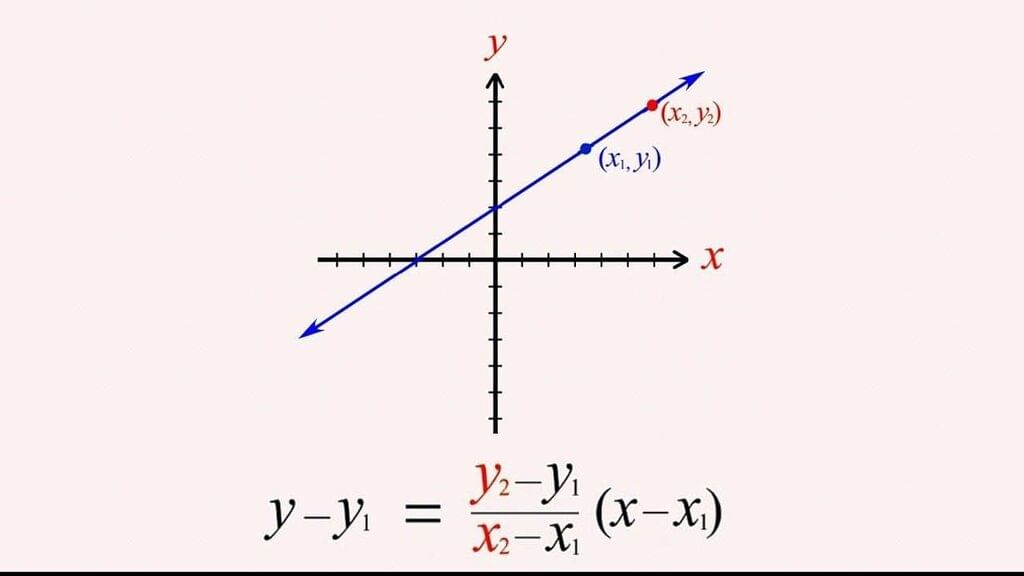
Two-Point Equation
Used when two points on the line are known.
Steps to derive the equation:
- Let the line pass through (x1, y1) and (x2, y2).
- Compute slope: m = (y2 - y1) / (x2 - x1).
- Apply point-slope form with one point.
Formula: y - y1 = m (x - x1), where m = (y2 - y1) / (x2 - x1).
Example: Find the equation of the line through (-3, 1) and (1, 5).- Step 1: Label points: (x1, y1) = (-3, 1), (x2, y2) = (1, 5).
- Step 2: Calculate slope: m = (5 - 1) / (1 - (-3)) = 4 / 4 = 1.
- Step 3: Use point-slope form: y - y1 = m (x - x1).
- Step 4: Substitute: y - 1 = 1 (x - (-3)).
- Step 5: Simplify: y - 1 = x + 3 → y = x + 4.
- Conclusion: The equation is y = x + 4.
Equally Inclined Lines
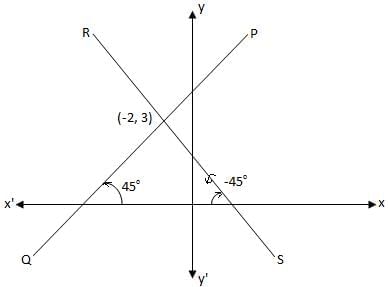
Inclined Lines
Equally inclined lines make equal angles with both x-axis and y-axis.
Steps to understand:
- For line AB, inclination θ = 45°, slope = tan 45° = 1.
- For line CD, inclination θ = -45°, slope = tan (-45°) = -1.
- Step 1: For line AB, slope m = tan 45° = 1, point (x1, y1) = (-2, 3).
- Step 2: Use point-slope form: y - y1 = m (x - x1).
- Step 3: Substitute: y - 3 = 1 (x - (-2)) → y - 3 = x + 2 → y = x + 5.
- Step 4: For line CD, slope m = tan (-45°) = -1, point (x1, y1) = (-2, 3).
- Step 5: Use point-slope form: y - 3 = -1 (x - (-2)) → y - 3 = -x - 2 → x + y = 1.
- Conclusion: Equations are y = x + 5 and x + y = 1.
To Find the Slope and Y-Intercept of a Given Line
Steps to find slope and y-intercept:- Rearrange the equation to the form y = m x + c.
- The coefficient of x is the slope (m).
- The constant term is the y-intercept (c).
- Step 1: Start with 2x - 3y - 4 = 0.
- Step 2: Solve for y: -3y = -2x + 4.
- Step 3: Divide by -3: y = (2/3)x - 4/3.
- Step 4: Identify slope: m = 2/3.
- Step 5: Identify y-intercept: c = -4/3.
- Conclusion: Slope is 2/3, y-intercept is -4/3.
Solved Examples
Example 1: Find the value of k
The line 3x - 8y = 2 passes through (k, 2). Find k.
- Step 1: Substitute x = k and y = 2 into 3x - 8y = 2.
- Step 2: Calculate: 3k - 8 × 2 = 2.
- Step 3: Simplify: 3k - 16 = 2.
- Step 4: Solve: 3k = 18 → k = 6.
- Conclusion: The value of k is 6.
Example 2: Check if a line bisects a segment
Does the line 3x = y + 1 bisect the segment joining A(-2, 3) and B(4, 1)?
- Step 1: Find midpoint of AB: [(x1 + x2)/2, (y1 + y2)/2].
- Step 2: Substitute A(-2, 3) and B(4, 1): [(-2 + 4)/2, (3 + 1)/2] = (1, 2).
- Step 3: Substitute midpoint (1, 2) into 3x = y + 1.
- Step 4: Check: 3 × 1 = 2 + 1 → 3 = 3, which is true.
- Conclusion: The line 3x = y + 1 bisects the segment joining A and B.
Example 3: Find the equation of a line
Find the equation of the line with x-intercept 8 and y-intercept -12.
- Step 1: x-intercept = 8 → point (8, 0).
- Step 2: y-intercept = -12 → point (0, -12).
- Step 3: Calculate slope: m = (y2 - y1) / (x2 - x1) = (-12 - 0) / (0 - 8) = 3/2.
- Step 4: Use point-slope form: y - y1 = m (x - x1).
- Step 5: Substitute: y - 0 = (3/2) (x - 8).
- Step 6: Simplify: 2y = 3x - 24.
- Conclusion: The equation is 2y = 3x - 24.
Example 4: Alternative method for equation of a line
Find the equation of the line through (2, 7) with y-intercept 3.
Method 1:
- Step 1: y-intercept = 3 → point (0, 3).
- Step 2: Given point (x1, y1) = (2, 7), (x2, y2) = (0, 3).
- Step 3: Calculate slope: m = (3 - 7) / (0 - 2) = -4 / -2 = 2.
- Step 4: Use point-slope form: y - y1 = m (x - x1).
- Step 5: Substitute: y - 7 = 2 (x - 2).
- Step 6: Simplify: y - 7 = 2x - 4 → y = 2x + 3.
Alternative Method:
- Step 1: Use slope-intercept form: y = m x + c, where c = 3.
- Step 2: Substitute point (2, 7): 7 = m × 2 + 3.
- Step 3: Solve for m: 7 = 2m + 3 → 2m = 4 → m = 2.
- Step 4: Substitute m and c: y = 2 x + 3.
- Conclusion: The equation is y = 2x + 3.
|
74 videos|198 docs|30 tests
|
FAQs on Equation of A Line Chapter Notes - Mathematics Class 10 ICSE
| 1. What is the concept of slope (or gradient) in geometry? |  |
| 2. How do you calculate the slope of a straight line passing through two fixed points? |  |
| 3. What is the condition for two lines to be parallel? |  |
| 4. What does it mean for two lines to be perpendicular? |  |
| 5. How can you determine the x-intercept of a line given its equation? |  |
















